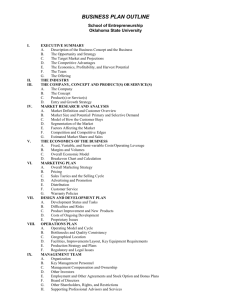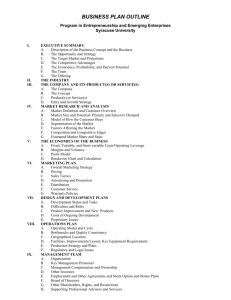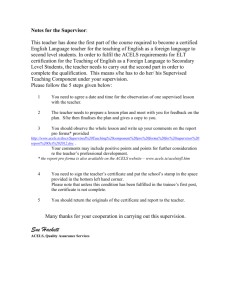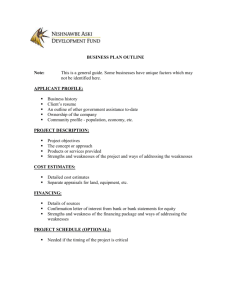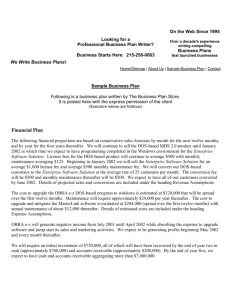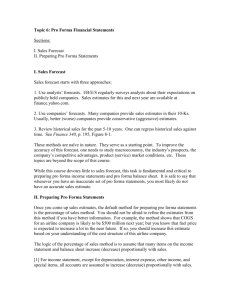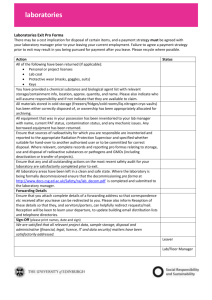Chapter 3 Lecture (Part III)
advertisement
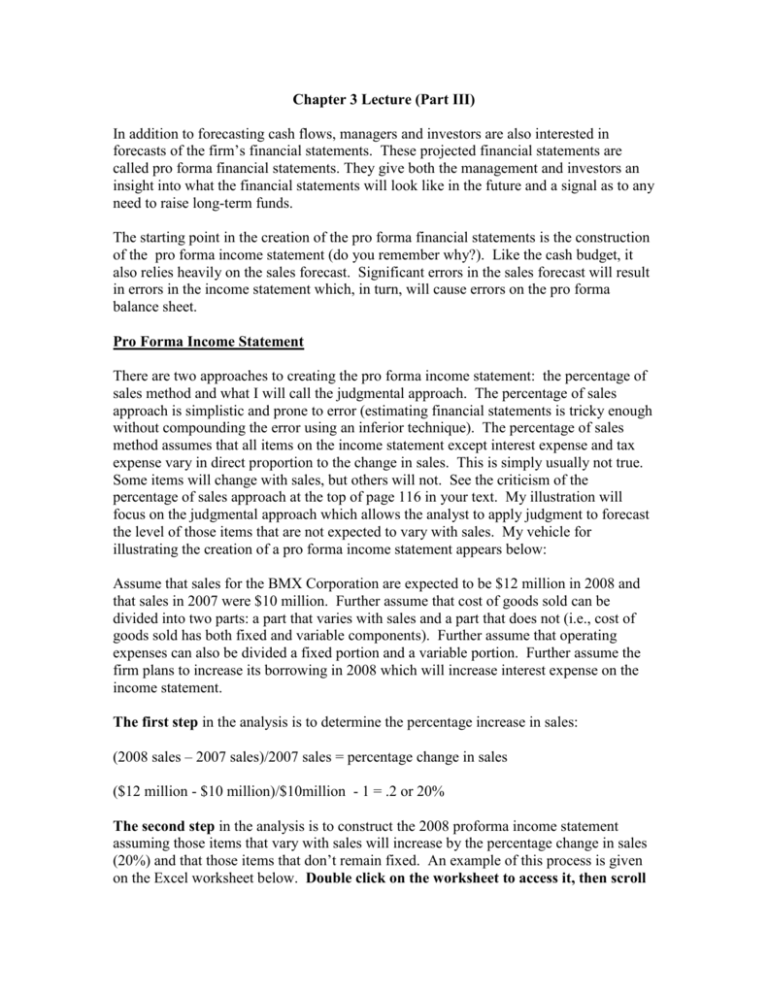
Chapter 3 Lecture (Part III) In addition to forecasting cash flows, managers and investors are also interested in forecasts of the firm’s financial statements. These projected financial statements are called pro forma financial statements. They give both the management and investors an insight into what the financial statements will look like in the future and a signal as to any need to raise long-term funds. The starting point in the creation of the pro forma financial statements is the construction of the pro forma income statement (do you remember why?). Like the cash budget, it also relies heavily on the sales forecast. Significant errors in the sales forecast will result in errors in the income statement which, in turn, will cause errors on the pro forma balance sheet. Pro Forma Income Statement There are two approaches to creating the pro forma income statement: the percentage of sales method and what I will call the judgmental approach. The percentage of sales approach is simplistic and prone to error (estimating financial statements is tricky enough without compounding the error using an inferior technique). The percentage of sales method assumes that all items on the income statement except interest expense and tax expense vary in direct proportion to the change in sales. This is simply usually not true. Some items will change with sales, but others will not. See the criticism of the percentage of sales approach at the top of page 116 in your text. My illustration will focus on the judgmental approach which allows the analyst to apply judgment to forecast the level of those items that are not expected to vary with sales. My vehicle for illustrating the creation of a pro forma income statement appears below: Assume that sales for the BMX Corporation are expected to be $12 million in 2008 and that sales in 2007 were $10 million. Further assume that cost of goods sold can be divided into two parts: a part that varies with sales and a part that does not (i.e., cost of goods sold has both fixed and variable components). Further assume that operating expenses can also be divided a fixed portion and a variable portion. Further assume the firm plans to increase its borrowing in 2008 which will increase interest expense on the income statement. The first step in the analysis is to determine the percentage increase in sales: (2008 sales – 2007 sales)/2007 sales = percentage change in sales ($12 million - $10 million)/$10million - 1 = .2 or 20% The second step in the analysis is to construct the 2008 proforma income statement assuming those items that vary with sales will increase by the percentage change in sales (20%) and that those items that don’t remain fixed. An example of this process is given on the Excel worksheet below. Double click on the worksheet to access it, then scroll up or down as needed. Notice the variable expenses are found by taking the 2007 expense and multiplying by 1 + the percentage change in sales (1.2). This increases those expenses by 120%. A common error students make is to simply multiply the variable expenses by the percentage change in sales. If we did that here, we would be multiplying the variable expenses by 20%. In other words, we would not be increasing variable expenses by 20%, we would be reducing them by 80%. Notice the pro forma net income for 2008 is $600,000. You may wish to analyze the effect using a strict percentage of sales approach would have had on pro forma net income. Would net income be higher or lower as a result? You would be correct to sense the potential for an exam question here. Finally $200,000 in dividends are deducted from the $600,000 net income giving us a $400,000 addition to retained earnings. Sales Less Cost of Goods Sold: Fixed Cost Variable Costs Gross Profits Less: Operating Costs Fixed Cost Variable Costs Operating Profits Less: Interest Expense Net Profits Before Taxes Less: Taxes (tax rate = 40%) Net Profits After Taxes Less: Common Stock Dividends $10,000,000 $12,000,000 $3,000,000 Use Judgment $5,000,000 $5,000,000 X 1.2 $2,000,000 $3,000,000 $6,000,000 $3,000,000 $500,000 Use Judgment $1,000,000 $1,000,000 X 1.2 $500,000 $100,000 Use Judgment $400,000 $160,000 $1,000,000 X .40 $240,000 $500,000 $1,200,000 $1,300,000 $300,000 $1,000,000 $400,000 $600,000 $200,000 The third step is to use the $400,000 pro forma additions to retained earnings in addition to a number of other assumptions to compute the Pro Forma Balance Sheet. I will also use the judgmental approach in this step. The 2007 historical balance sheet and the pro forma balance sheet for BMX Corporation appear in the Excel worksheet below. To access the worksheet, double click on it, then scroll up or down as needed to see view the worksheets. I will make the following assumptions regarding the pro forma balance sheet: 1. The firm wants to continue to maintain a minimum cash balance of $100,000 2. Marketable securities will increase to $75,000 in 2008. 3. Accounts receivable have historically been 36.5 days of sales. Since sales for 2008 are expected to be $12,000,000, accounts receivable will be $12,000,000 x (36.5/365) = $1,200,000 (you could also do the following which is algebraically identical: ($12,000,000/365) X 36.5). 4. Inventories have historically been 20% of cost of goods sold. Since cost of goods sold for 2008 are expected to be $9,000,000, inventories will be $9,000,000 x .20 = $1,800,000. 5. Vectra will increase fixed assets by $750,000. Depreciation expense for 2008 is estimated to be $200,000. Net fixed assets for 2008 will be: Net fixed assets (2007) + additions to fixed assets – depreciation expense 2008 $5,000,000 + $750,000 $200,000 = $5,550,000 6. Annual purchases (all on account) have historically averaged 60% of cost of goods sold. The accounts payable balance, in turn, is typically 20% of purchases. Accounts payable will therefore be $9,000,000 X .60 X .20 = $1,080,000 7. Taxes payable will be approximately one quarter of the tax expense shown on the 2008 pro forma income statement. Taxes payable will equal $400,000/4 = $100,000. 8. Notes payable will increase to $1,000,000. 9. There will be no change in other current liabilities, long-term debt, or common stock. 10. Retained earnings on the 2008 pro forma balance sheet will change by the additions to retained earnings ($400,000) shown on the pro forma income statement. Since the 2007 retained earnings was $1,000,000, the retained earnings for 2008 are expected to be $1,000,000 + $400,000 = $1,400,000. Marketable securities Accounts Receivable Inventories Total Current Assets Net Fixed Assets Total Assets $75,000 $1,200,000 $1,800,000 $3,175,000 $5,550,000 $8,725,000 Taxes Payable Notes Payable Other Current Liabilities Total Current Liabilities Long-term Debt Common Stock Retained Earnings Total Liabilities and Equity External Financing Required Total After Financing Notice the 2008 pro forma balance sheet did not initially balance: e.i., total assets ($8,725,000) did not equal the sum of total liabilities and equity ($8,332,500). In other words, the firm’s need to fund assets of $8,725,000 in 2008 will not be met at anticipated levels of debt and equity. This is the firm’s signal that it will have to raise funds by issuing additional debt or equity in the amount of $392,500. $100,0 $1,000,0 $500,0 $2,680,0 $1,000,0 $3,252,5 $1,400,0 $8,332,5 $392,5 $8,725,0

